As an Amazon Associate, I earn from qualifying purchases.
Choosing the best laptop for Photoshop can be difficult, especially when you’re not a dedicated tech journalist. With hundreds of different laptop models available at wildly differing price points, it’s tough to sort through all the noise and figure out which features you actually need for Photoshop, which features are nice bonuses to have, and which ones you can do without.
I’m an experienced photographer who also has a fascination with computer hardware, so I can help translate the tech jargon into (almost) normal English. My name is Thomas Boldt, and I’ve been working with Photoshop since version 5.0, way back in the days when iMacs were still built into giant CRT monitors.
I source all of my own computer hardware very carefully, and all the laptops that I’ve chosen to showcase here meet the high standards that I set for the tech I rely on for my own photographic work. I’m overdue for a new laptop myself, and I’ll be choosing the best laptop for Photoshop that I can find, which means I’ve currently got my eye on the best overall pick listed below.
In this review, I’ll cover the most important things to consider when choosing the best laptop for Photoshop, explain how they can affect your editing workflow, and pick out four different laptops that are perfect for different types of Photoshop users.
Table of Contents
Key Takeaways
- The four most important factors when buying the best laptop for Photoshop are CPU speed, memory capacity, storage disk speed/capacity, and screen quality.
- 16 GB of memory is a good starting point for Photoshop, but 32 GB is much better.
- A high-capacity PCIe solid-state drive will speed up file loading and Photoshop’s scratch disk usage.
- The screen should display 100% of the sRGB colorspace used in digital graphics, but the best screens also display 100% of the AdobeRGB colorspace used in high-end photography.
- If you prefer Windows, Dell XPS 17 is the best overall choice and ASUS Studiobook 16 is the budget pick.
- Mac power users will love the 16” Macbook Pro M2 Max, and the 13” Macbook Pro M2 is perfect for digital nomads who need portability.
What Makes a Laptop Perfect for Photoshop?
As I mentioned at the start of this article, there are four key factors that you need to consider when buying a laptop specifically for Photoshop: CPU speed, RAM capacity, storage disk speed, and screen quality. Since you’re probably not a tech fanatic like I am, let’s take a quick look at each factor to see how it can impact your Photoshop work.
CPU Speed
Many people focus heavily on CPU speed because it’s fairly simple – more speed is better – but CPU speed isn’t the only important factor to consider. More speed usually also means higher power usage, which in turn means shorter battery life, so finding a good balance between these factors is important.
Look for a CPU with a base clock speed above 3 Ghz and, ideally, a boost clock reaching above 4 Ghz. If you’re planning to use your laptop on battery power when working in Photoshop, it’s useful to have a CPU that can run at high power/speed when you need it and then switch to a low-power/high-efficiency mode when you’re not busy.
Memory Capacity
The amount of RAM (Random Access Memory) that’s installed in your laptop also has a big impact on how well Photoshop runs and how well the rest of your apps will run while Photoshop is open.
Photoshop requires a base minimum of 8 GB of RAM to run at all, but that will give you very limited performance. Loading large Photoshop documents while running other apps in the background will slow your laptop to a crawl, so I recommend a minimum of 16 GB of RAM to get a decent experience.
If you’ve got the budget for the upgrade, 32 GB of RAM will allow you to load multiple high-resolution files at once while running other apps like Lightroom and a web browser without any issues. You can consider adding as much as 64 GB, but this is a bit excessive for most Photoshop users, and there are diminishing performance returns – and increasing prices – once you go above 32 GB.
Storage Drive
This is arguably the most important yet under-appreciated part of finding the best laptop for Photoshop. In addition to storing all your documents and apps, Photoshop uses your laptop’s storage drive as a temporary storage area known as a ‘scratch disk’ for history states and other aspects of your document that aren’t being kept in RAM. This gets a bit technical, and you can read more about it here on the Adobe website if you’re curious, but it’s not required knowledge.
Simply put, Photoshop does a great deal of reading and writing to the storage drive, so a fast solid-state drive that uses the PCIe interface will prevent your Photoshop scratch disk from causing any delays in your workflow.
Screen Quality
Screen quality is last on the list, but it’s just as important as all the other elements. Of course, it’s always possible to use an external monitor for checking color accuracy, but that just adds another expense that you might prefer to avoid – especially when you can get a laptop with a high-quality screen built-in.
To make it great for Photoshop, your laptop screen should be able to display 100% of the standard sRGB color gamut. But if you want to pull out all the stops, look for a screen that can also display 100% of the Adobe RGB color gamut typically used in photographic printing.
While a good screen will display a very wide color gamut, it’s absolutely essential to use a color calibration device to verify that it is displaying colors properly. Some laptops claim to be calibrated out of the box, but even still, it’s a good idea to double-check before doing serious color work.
Best Laptops for Photoshop Reviewed
Now that you know what matters, let’s take a look at the best laptops for Photoshop and how each one excels in the four key areas. Since there are so many different situations that benefit from a laptop, I’ve selected four laptops that meet a variety of different needs so you can choose the best one for your personal requirements.
1. Best Overall Laptop for Photoshop: Dell XPS 17
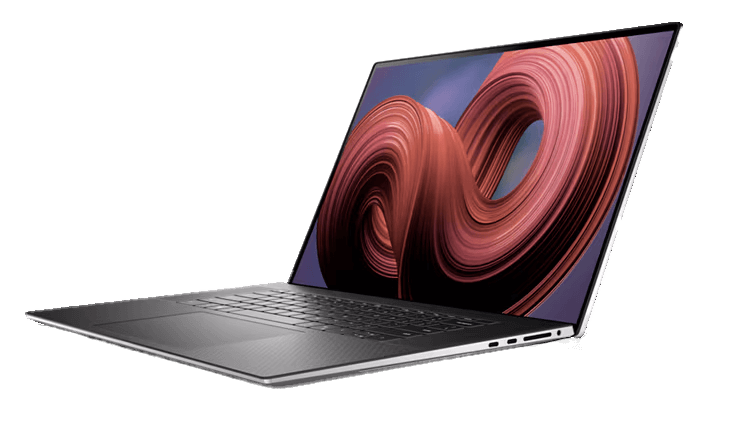
- CPU: Intel Core i9-12900HK (14 cores, 20 threads, up to 5.0 GHz)
- RAM: 32 GB DDR5
- Storage: 1 TB PCIe solid-state drive
- Screen: 17-inch 3840 x 2400 touchscreen, 100% sRGB, 100% Adobe RGB
This laptop is a powerhouse packed into the standard XPS design. The CPU is powerful enough for anything you can ask Photoshop to do, and the high core count combines 6 performance cores with 8 efficiency cores for good battery life when you’re not doing any heavy editing.
32 GB of DDR5 RAM and a fast 1 TB storage drive can handle all your Photoshop editing needs, allowing you to edit multiple large Photoshop documents at the same time while also running Lightroom and other apps in the background without any delays. There’s even a discrete graphics processing unit (GPU) with 6GB of video memory to further smooth out your Photoshop experience.
The screen is one of the most impressive features of this laptop, reaching an impressive brightness level while also maintaining excellent color accuracy. The resolution is slightly higher than 4K, and it displays 100% of the sRGB color gamut used for digital work. It can even display 100% of the Adobe RGB color gamut used in photographic printing, which is a rare and impressive achievement for most desktop monitors, let alone a laptop screen.
Of course, all this power comes at a price. All of the best laptops for Photoshop are priced on the expensive side of things, but the Dell XPS 17 is very close to the top of the list. You can find various other configurations to save on cost, but you’ll have to compromise on performance.
The TLDR summary: If you need a laptop that will power through any Photoshop task you can throw at it, then Dell XPS 17 is your best option.
2. Best Mac Laptop for Photoshop: Macbook Pro 16” (M2 Max Edition)
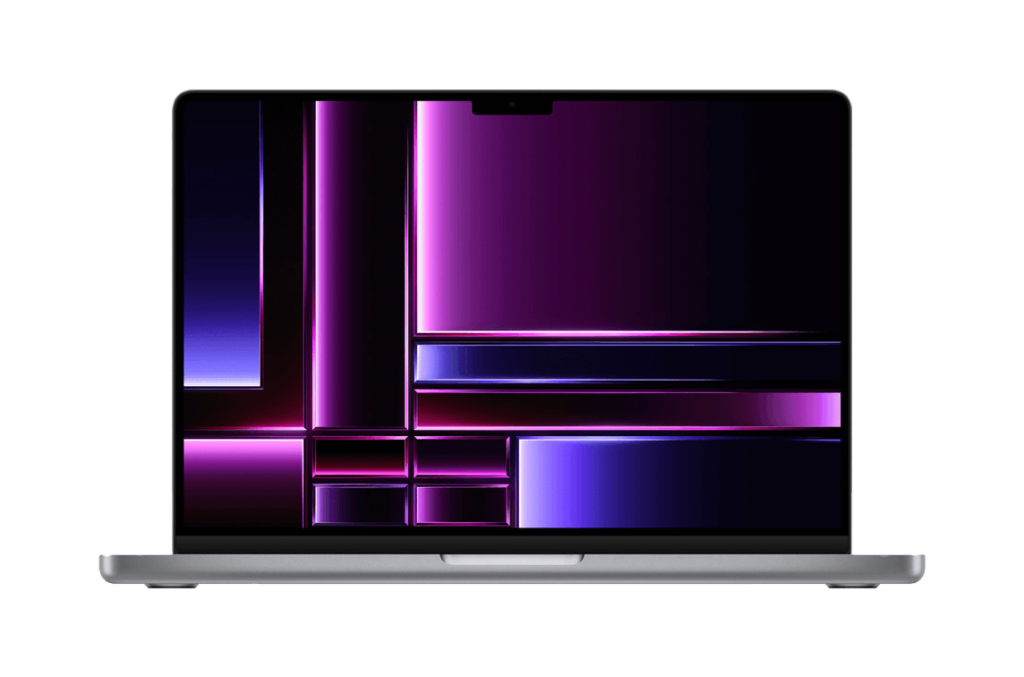
- CPU: Apple Silicon M2 Max (12 cores, up to 3.7 GHz)
- RAM: 32 GB DDR5
- Storage: 1 TB PCIe solid-state drive
- Screen: 16” Liquid Retina display, 3456 x 2234 resolution, 100% sRGB, 90% Adobe RGB
Featuring the M2 Max chip, this laptop uses the most powerful CPU that Apple makes. The M2 chip does quite well with Photoshop workloads and matches the CPU found in the Dell XPS 17 pretty closely in synthetic benchmarks, although I’m not going to get into the hyperfocused comparisons between Intel and Apple chips.
32 GB of RAM is enough for all but the most demanding Photoshop workflows and the MacBook’s speedy 1 TB solid-state drive will give Photoshop plenty of room for the scratch disk without causing any bottlenecks.
If you’re planning to use Photoshop entirely for digital projects, then the Macbook screen’s perfect 100% coverage of the standard sRGB colorspace is all you need. It also has a peak brightness of 1200 nits of brightness, which allows you to work just about anywhere.
Interestingly, despite Apple’s typical marketing toward creative professionals, the screen only covers around 90% of the Adobe RGB colorspace, so it’s not quite good enough for photographic print work that depends on color accuracy. You can always connect an external monitor for color-sensitive print work, but you may not want to deal with the hassle.
If you thought the Dell XPS 17 was expensive, then brace yourself for the cost of the 16” Macbook Pro because it’s the priciest laptop on this list. Combining power and style in one portable machine gets expensive quickly!
The TLDR summary: If you’re committed to the macOS world, then Macbook Pro 16” M2 Max is the best laptop for Photoshop that you can buy.
3. Best Value Laptop for Photoshop: ASUS Studiobook 16
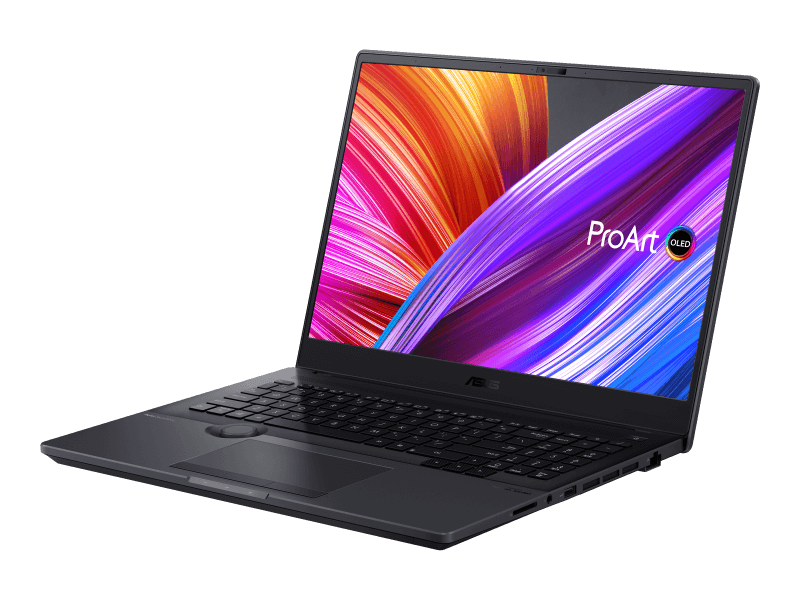
- CPU: AMD R7 5800H (8 cores, up to 4.4 GHz)
- RAM: 32 GB DDR4
- Storage: 1 TB PCIe solid-state drive
- Screen: 16” 2560 x 1500 display, 100% sRGB, 100% Adobe RGB
This laptop is the only one on the list featuring an AMD processor, which helps position it at the more affordable end of the pricing spectrum. The 5800H isn’t the most powerful processor out there, but it’s more than capable of running Photoshop smoothly, along with a few other apps in the background.
The Studiobook 16’s 32 GB of RAM has enough capacity for most Photoshop workloads, although it uses the older DDR4 standard instead of the new DDR5 standard used by the other laptops on this list. Additionally, the PCIe solid-state drive uses the PCIe 3.0 specification instead of the newer and faster PCIe 4.0 spec, but it’s still fast enough to let your Photoshop scratch disk operate smoothly.
The screen on this Studiobook is a lower resolution than the other choices listed here, but it’s got impressive brightness, full coverage of the sRGB and AdobeRGB color gamuts, and boasts color calibration verified by Pantone. You should probably still color-calibrate the screen once you get it unboxed, but that’s also true of all the other laptops listed here.
One last feature of note that’s unique to the Studiobook line is the ASUS dial. Located below the keyboard, this dial works perfectly with Photoshop to make quick adjustments to settings sliders, brush sizes, and more.
If you like the Studiobook style and the handy ASUS dial feature, but you want more power, you can find many different configurations that will be even better at running Photoshop – just keep in mind that the price starts to go up very quickly.
The TLDR summary: ASUS Studiobook 16 is the best PC laptop for those who need good value from their laptop purchase on a limited budget.
4. Best Ultraportable for Photoshop: Macbook Pro 13” (M2 Edition)
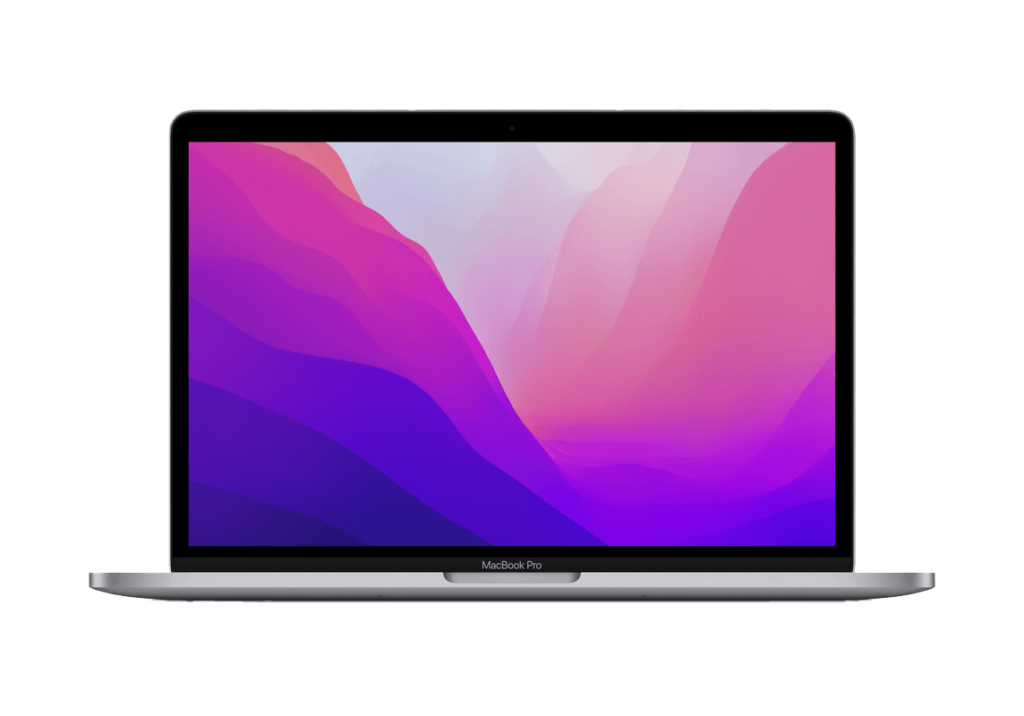
- CPU: Apple Silicon M2
- RAM: 16 GB DDR5
- Storage: 1 TB PCIe solid-state drive
- Screen: 13” Liquid Retina display, 100% sRGB gamut, 90% Adobe RGB gamut
Most of the laptops on this list are big-screen beasts, but sometimes you just need more portability. The 13” Macbook Pro sits at a strange place in the Apple laptop hierarchy since the Macbook Air has the same price point and essentially the same specs, but the fact that the Macbook Pro has an active cooling system means that Photoshop can use the full power of the M2 chip for longer without experiencing any kind of thermal throttling.
16 GB of RAM and a fast 1 TB storage drive are more than enough for smooth Photoshop editing since you probably won’t be immersed in a heavy-duty workflow on a 13-inch screen.
The 13” MBP has an almost identical screen to its larger 16” cousin, which means that it has the same impressive brightness, the same 100% sRGB coverage, and the same slightly disappointing 90% Adobe RGB coverage. This matters less for an ultraportable laptop, though, since the screen is a bit too small for high-precision editing of the large files used in photographic print work.
One additional point: the 13-inch MBP is the only one that still features the Touch Bar, a dynamic area above the keyboard that allows you to customize buttons for use in Photoshop and other apps. Some people love it, and some people hate it, but it can be a great help for Photoshop.
The TLDR summary: Macbook Pro 13” M2 is a very portable laptop with all-day battery life that still has the tech specs for some serious Photoshop work.
FAQs
Here are some of the most frequently asked questions about running Photoshop on a laptop. If you’ve got another question that isn’t included here, let me know in the comments below, and I’ll do what I can to help!
Can you run Photoshop on any laptop?
No, you can’t run Photoshop on just any old laptop. Adobe has a set of system requirements that your laptop must meet, or Photoshop will not run properly. Many laptops can run Photoshop badly, and there are also quite a few that run Photoshop very well, but unless your laptop meets or exceeds the minimum system requirements, you won’t even be able to load the app.
How much RAM do I need for Photoshop?
It depends on how you plan to use Photoshop. You can run Photoshop and edit a high-resolution DSLR photo with the minimum requirement of 8 gigabytes of RAM, but you’ll start to notice performance issues as soon as you start running other apps at the same time or if you try to open more than one large file in Photoshop.
I recommend a base minimum of 16 GB of RAM if you’re serious about Photoshop work, but if you’ve got the budget for it, upgrading to 32 GB of RAM will allow you to edit multiple large Photoshop documents and run other apps in the background without any issues. Learn more about this topic from this post.
Is a laptop or desktop better for Photoshop?
In most comparisons, desktop computers tend to be more powerful because they don’t have to worry about balancing power consumption and battery life, but that doesn’t make them better in every situation.
A desktop computer is very difficult and tedious to move around, while a laptop can be closed up and tucked away in a travel case in just a few seconds. That portability also means that laptops have smaller screens than a typical desktop monitor, which can limit your productivity a bit – there’s always a trade-off!
One popular solution is to buy a powerful laptop and connect it to an external keyboard, mouse, and monitor while you’re at your desk. When you need to take your machine to a client meeting across town or on a business trip to the other side of the world, you can just disconnect your external devices and pack your laptop in its travel bag.
A Final Word
Choosing the best laptop for Photoshop is always a big decision, but hopefully, you’ve learned enough about the tech specs to make an informed choice about the perfect laptop for you. No matter which laptop you choose from our selections above, you can be confident that you’re going to get a great experience with Photoshop- and for almost any other task.
Have fun making your selection – and if you’re still not sure which laptop to choose, let me know in the comments below and I’ll try to help.
About Thomas Boldt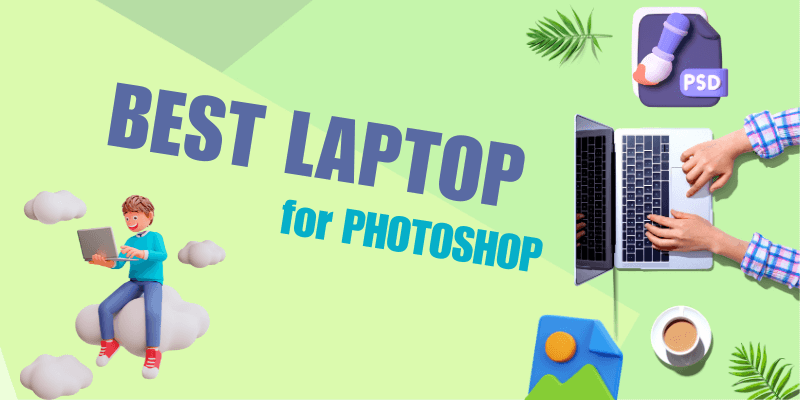
Robert
Hello Thomas,
I just read your article, and it is very helpful. Here is my situation though. I am an old school photographer with forty years of photography work. Much of which is 35mm slide pictures.
I have digitized those slides, and I want to use photoshop to improve those images, and more. I am looking to start a website as well. Maybe do some youtube videos.
I was schooled in photography in the seventies and worked professionally for a few years in the military. But was never able to make a living as a photographer. Life sort of put me on a different path.
Now I want to do what I have always wanted to do. But there is just too many computers out there, and I am on a limited budget being now retired.
Would you have a recommendation for what I am looking to do?
Thomas Boldt
Hi Robert, I’m glad you found the article helpful! You’re not the only one who gets frustrated by how many different models of laptop are out there nowadays, trust me =)
If you’re on a limited budget, the ASUS StudioBook 16 would be a good choice for a Windows machine, but if you prefer Macs, then you should look at the new (and not mentioned in the article) MacBook Air 15″. The MacBook Air 13″ is slightly cheaper, but I recommended it before the 15″ version even existed, and the extra screen space on the 15″ version is preferable for photo editing. Apple also has a monthly payment plan that might make it easier to afford the cost.
However, if you want to explore even more models than I can recommend, here are two points to keep in mind:
– Cheaper laptops will generally be slower, but you have to decide for yourself where to draw the line between speed and cost. Most cheaper ones still get the job done, you just have to be more patient with them. Make sure that anything you buy meets the minimum system requirements for Photoshop, and ideally, exceeds them by a bit.
– If it’s going to be your only computer, it’s essential to choose one with a good quality screen that can display at least 100% of the SRGB color gamut and ideally 100% of the AdobeRGB gamut, because color accuracy really matters when you’re working with photos.
Rediscovering your creative passion is a joy to experience at any point in your life, so I really hope that I could help a little! If you’re still not sure what to choose, maybe let me know what your budget is and I can try to point you in a more specific direction.